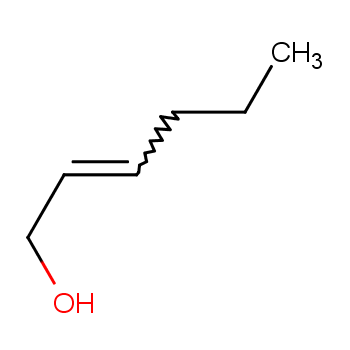Overview[1]
trans-2-Hexen-1-ol is a volatile component found in tea. It was first discovered in tea leaves in 1966. This colorless liquid is slightly soluble in water and soluble in organic solvents such as ethanol. It has a boiling point of 155℃, a relative density of 0.8498 (16/4℃), and a refractive index of 1.4367 (20℃). It has a strong grassy odor. It is present in fresh tea leaves and processed tea, with a significant increase during the withering stage of tea leaves and a decrease during fermentation and drying.

Applications[2-4]
1. It is used in the synthesis of a compound called E10, E12-hexadecadienal, which is a sex pheromone component of the bean leafroller.
The compound is synthesized using trans-2-Hexen-1-ol and 1,10-decanediol as substrates. Trans-2-Hexen-1-ol is converted to a bromide through halogenation, which then reacts with triphenylphosphine tribromide to obtain triphenylphosphonium ylide. 1,10-decanediol is esterified to obtain acetyl-protected 1,10-decanediol, which is then oxidized to obtain 10-oxydecyl acetate. The triphenylphosphonium ylide and 10-oxydecyl acetate undergo a Wittig reaction followed by quenching to separate 10,12-hexadecadienol. The trans structure of trans-10,12-hexadecadienol is obtained through recrystallization, and then it is oxidized to obtain E10, E12-hexadecadienal. This method uses relatively inexpensive and easily available raw materials, has a simple and rational synthesis route, and is safe and easy to operate, with high raw material utilization and low cost, allowing for the synthesis of the main component of the bean leafroller sex pheromone in a short period of time.
2. It is used in the preparation of tomato flavoring, which is a mixture of trans-2-Hexen-1-ol, acetic acid, geraniol, isobutanol, trans-2-hexenal, cis-6-nonenol, geranyl acetate, hexenyl acetate, limonene, 2-isobutylthiazole, guaiacol, dihydroeugenol, and 95% ethanol.
This tomato flavoring has a fresh and natural tomato aroma, with a harmonious and mellow fragrance that complements tobacco aroma, enhancing the smooth and sweet sensation of cigarettes. It has a mild and long-lasting fragrance that can enhance the natural aroma of tobacco and improve the quality and taste of cigarette smoke. It can also improve the mouthfeel, add a refreshing aroma to cigarettes, and reduce the harshness. This invention provides a new raw material for cigarette flavoring, with a simple and reproducible technology that is easy to implement for industrial production, creatively applying tomato flavoring to cigarettes.
3. 2-Propyl-cyclopropane-carboxaldehyde is a new fragrance compound with a green aroma. It has a similar aroma to trans-2-hexenal but with better storage and usage stability, providing more options for the production of aromatic products.
CN200910046883.9 discloses a new compound, 2-propyl-cyclopropane-carboxaldehyde, and its preparation method. One synthesis method involves the cyclopropanation reaction of trans-2-hexenal with trimethylsulfonium iodide and sodium hydride in dimethyl sulfoxide solvent under nitrogen protection to obtain the product, 2-propyl-cyclopropane-carboxaldehyde. Another two-step synthesis method uses trans-2-Hexen-1-ol as a raw material and reacts it with zinc powder, cuprous chloride, and acetyl chloride as catalysts in diethyl ether to obtain the intermediate, 2-propyl-cyclopropane-carbinol, which is then oxidized to obtain the product, 2-propyl-cyclopropane-carboxaldehyde. This compound is a fragrance with a green aroma, similar to trans-2-hexenal but with better storage and usage stability. It can be used in perfumes, detergents, fabric softeners, cosmetics, personal care products, and indoor air fresheners.
Main References
[1] Chinese Tea Dictionary
[2] [Chinese Patent, Chinese Patent Authorization] CN200710156845.X Method for synthesizing E10, E12-hexadecadienal, a sex pheromone component of the bean leafroller
[3] CN201310536729.6 Tomato flavoring
[4] CN200910046883.9 Compound 2-propyl-cyclopropane-carboxaldehyde and its preparation method




